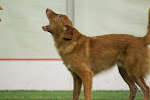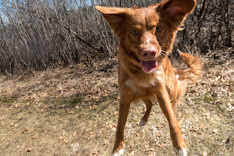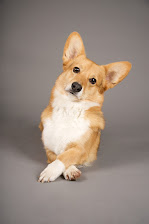Using corrections, positively
I consider myself a positive trainer. I also use corrections in my training. Here's the deal, a correction does not have to equal "punishment." Training has come a long way, even balanced trainers shout out against abusive techniques such as kicking, stringing a dog up, and alpha rolls.
Many positive trainers use negative punishment; removing access to the reward. The dog doesn't sit? Don't give the dog a treat, don't throw the ball, don't open the door to go outside, ignore the dog... But I think that for sport dog training that isn't enough. Your balanced
trainers will agree, saying that you can't train a dog to reliable
levels by simply
withholding the reward. Now don't misunderstand me. I think you can
get really far in training by simply setting up your training so that
you have great control of the rewards available AND have taught your dog
a solid foundation so that he knows how to gain access to those
rewards. Without the use of any physical OR verbal corrections you can
train a dog to do some pretty remarkable things among very heavy
distractions. The dog develops self control versus being told what to do all the time.
.jpg) However, I still think that sticking to the negative punishment quadrant is 1. severely limiting when you get to advanced levels and 2. almost impossible. At some point when a dog understands the exercise you need to start diminishing the dog's reward schedule. Of course where a balanced trainer defines a dog as "knowing" something and where a positive trainer defines this line is often drastically different. But regardless of where that line is defined, one has to think about fading the food/toys. In agility where the runs last about 30seconds and the activity is much more fast paced, this rarely becomes an issue. But in obedience where a team is often in the ring for 4 to 8 minutes, or even longer outside the U.S., it needs to be addressed. Positive trainers often suck at this aspect, thus my vow to work hard in the New Year to increase the value of my personal play and severely limit external rewards in Lance's training.
However, I still think that sticking to the negative punishment quadrant is 1. severely limiting when you get to advanced levels and 2. almost impossible. At some point when a dog understands the exercise you need to start diminishing the dog's reward schedule. Of course where a balanced trainer defines a dog as "knowing" something and where a positive trainer defines this line is often drastically different. But regardless of where that line is defined, one has to think about fading the food/toys. In agility where the runs last about 30seconds and the activity is much more fast paced, this rarely becomes an issue. But in obedience where a team is often in the ring for 4 to 8 minutes, or even longer outside the U.S., it needs to be addressed. Positive trainers often suck at this aspect, thus my vow to work hard in the New Year to increase the value of my personal play and severely limit external rewards in Lance's training.
Back to my point, when a behavior is past the shaping phase a dog needs to know if he was correct or not and the lack of reward can NOT be the defining marker. In the ring, silence has to equal good so training otherwise invites a whole host of problems. I know I initially struggled on this with Lance when we first started trialing and Lance thought the absence of a treat meant he was wrong. The great news is that the more positive your training becomes the less harsh your corrections need to be. Even Bubba the Schipperke who could care less in the beginning what I thought of his actions, became quite sensitive as our relationship grew. But only to me of course, to others he repeatedly gave the finger :)
In my training, I can think of 2 type of corrections for the dogs. First, I prefer to interrupt the wrong behavior immediately. Apparently what usually comes out of my mouth is an "oh buddy!" or my similar phase of "dude!!!" Said in an upbeat voice, the sole purpose is to let the dog know we're going to start that attempt again and it's often accompanied by clapping or even some light playful pushes on the dog. A happy interrupter. In technical terms, I think this type of interruption is positive punishment. It doesn't use pain, even mildly, but it is an aversive to the dog. I think of it as slight nag, albeit a happy one. In some cases this is followed by me quickly running back to the dog to replace them, like when doing signals or directed jumping. And then on activities where the dog is positioned around me such as heeling, fronts, and finishes, I like to quickly exaggerate their error so the dog now has to work harder to be right. Crooked front or finish- I side step the other direction. Lagging- I speed up. Look away for a second- I'm likely in the opposite direction by now. I think you get the idea.
The other correction I use, although not very often is pressure. Stepping into the dog's space, even if you're across the room, can be highly effective in training. I use a little bit of pressure on Lance's heeling by doing a sharp left turn into him whenever he forges. I don't touch him, but now he has to back up quite a bit to get back into position and get out of my way. I also use pressure as a correction for getting the signals wrong or moving on them, by taking a step towards the dog and often telling them to back up. I think as I develop into a better trainer I use pressure less often and corrections in general less often.
I should also add that in my training the dog always has a choice. I will not force a dog to do an exercise or to train with me. If the dog wants to leave training then I would take a serious look at my training to see why. I consider it MY job to try and make obedience fun for the dogs.






I think the key point you made is about working with the dog consistently. I found that even with Mango, who was a bit daft, the more often we trained, the better he responded to a verbal and did not need his cookies as much. I've avoided formal obedience for the reasons you mentioned. All the body language and verbal queues have to be tucked away during obedience. I'm starting rally next month with Dex. Something a little more exciting than obedience, but not as mad as agility.
Mango Momma
Hi Lance, Vito, Luke & the ferrets - long time no woof! I'm finally starting to catch up with blog friends!
I know I've missed a lot of your posts - I think I'll have to come back to read those - but just wanted to say a quick hello and thank you for all the lovely comments you have left on my blog recently!
Slobbers,
Honey the Great Dane
ps. Hsin-Yi LOVED this post and said she found it so interesting and helpful because she is one of those trainers you mentioned who uses "correction" as well as reward but she always feels very guilty about this because it seems like such a BAD thing in the modern dog training world.
But the way you explained it made so much sense and made her realise that she does basically the same thing as you. Most of her "corrections" to me are verbal interruptions (not stuff like yanking on my collar!!) and I'm really sensitive to that - her most common thing is to do this sound with her tongue, like a click or a "tch!" - and I instantly respond to that. But she always immediatley follows that up with happy voice & praise - which is sort of like what you do with backing up & more fun, etc.
But I'm like your Bubba - I respond immediately to any "correction" from Hsin-Yi but I tend to totally ignore other people - unless they've shown enough authority to earn my respect first!! ;-)
Anyway, Hsin-Yi so agrees with everything you said - including how she feels that you do need to add a bit of "positive punishment" to achieve the really high standards. But like you said, that's only after us doggies have had time to learn the behaviours properly - which she always teaches positively. But after we know it - well, a doggie like me gets bored easily and starts getting lazy - and Hsin-Yi finds that the best treats in the world (or withholding them) doesn't motivate me sometimes - whereas a LITTLE bit of "correction" can really make me lift my game! :-)
I agree with you about correction. I use it as well, though mildly, and differently for different dogs. Even with Quinn's Quiet/Woof exercise, for example. He learned Quiet/Woof with treats, which he picked up on really well. But now, as he grows up, I want him to respond to Quiet even if there are noises going on or I'm training the other dogs. Just saying 'Quiet' for a reward to him sometimes doesn't get me a quiet. But, a light tap on the head (happy slapplies), convinces him that I mean Quiet. Then when he's quiet, he gets a treat. Though dang, training a collie to be Quiet is not an easy challenge! Quinn is proving to be extremely sensitive, too. While he gets into everything, can be pushy and obnoxious... he responds to very slight correctly in a profound way. Good for me to know. :)
In obedience training, I'll also use pressure... step-ins and such. With Jet, I don't use much at all. Sometimes a verbal 'ack' or something to show him that's not what I want. I agree with you that, for the high-level obedience training, where you go into the ring, and there's nothing but you and the dog for 4-8 minutes, you gotta give the dog information and tell him what's not right, as well as what's right. In a way that doesn't shut him down or make him afraid. Obedience training is a huge challenge!
Thanks guys! I do believe that the more positive you train the more sensitive dogs become to corrections. A verbal correction is enough to melt a lot of the dogs I work with.
cynthia, collies are something aren't they?! There have been a few smooth coated collies in our service dog program and they certainly are challenging for our puppy raisers. Too smart for their own good! And they sure like to voice their opinion about things.